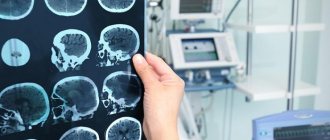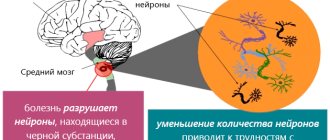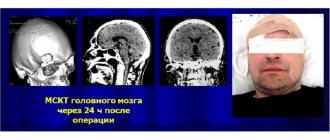THE ESSENCE OF THE PROBLEM
Mental retardation is a serious limitation in the skills necessary for daily life, social and intellectual activities. Such individuals experience problems with speech, motor development, intelligence, adaptation, emotional-volitional sphere, and cannot interact normally with the environment.
This definition was given by AAIDD - the American Association for Developmental and Intellectual Disabilities, which changed its approach to this problem. It is now believed that providing ongoing, personalized support can improve the quality of life of a mentally retarded person. Yes, the term itself was replaced with a more tolerant and inoffensive one – “intellectual disability”.
In addition, such a disease is now not considered mental. And it should not be confused with developmental disabilities. The latter covers a broader area, but is very closely related to the first: autistic disorders, cerebral palsy, etc.
Oligophrenia is a chronic non-progressive disease that occurs as a result of brain pathology in the prenatal period or after birth (up to three years).
Despite the achievements of modern medicine and serious preventive measures, it cannot give an absolute guarantee that this disease will not appear. Currently, 1 to 3% of people worldwide suffer from UO, but most suffer from a mild form (75%).
There is also acquired mental retardation - dementia. This is a separate “age-related” pathology in older people, a consequence of natural brain damage and, as a result, the collapse of mental functions.
CAUSES
Intellectual disability is the result of genetic diseases and many other factors, or rather, their combination: behavioral, biomedical, social, educational.
| Causes | Factors | |||
| biomedical | social | behavioral | educational | |
| Intrauterine development of the fetus (prenatal) | -age of parents; - diseases in the mother; -chromosomal disorders; -congenital syndromes | the mother's miserable existence, she was subjected to violence, was poorly fed, did not have access to medical services | parents used alcohol, tobacco, drugs | parents are not prepared for the birth of a child, are cognitively incompetent |
| Birth of a child (perinatal) | -prematurity; - birth injuries | poor baby care | child abandonment | lack of medical supervision |
| Later life (postnatal) | -bad Education; -brain injuries; -degenerative diseases; -epilepsy; -meningoencephalitis | -poverty; -poor family relationships | -domestic violence, harshness towards the child, isolation; -failure to comply with safety measures; -bad behavior | -poor quality medical care and late diagnosis of diseases; -lack of education; -lack of support from other family members |
No one can accurately name the specific “culprits,” even despite fairly scrupulous research and early diagnosis. But, if you analyze the table, the most likely cause of oligophrenia may be:
- any genetic failures - gene mutations, their dysfunction, chromosomal abnormalities;
- hereditary developmental disorders;
- malnutrition;
- infectious diseases of the mother during pregnancy - syphilis, rubella, HIV, herpes, toxoplasmosis, etc.;
- premature birth;
- problematic childbirth - asphyxia, mechanical injuries, hypoxia, fetal asphyxia;
- insufficient upbringing of the child from birth, parents devoted little time to him;
- toxic effects on the fetus leading to brain damage - parental use of strong drugs, drugs, alcoholic beverages, smoking. This also includes radiation;
- infectious diseases of the child;
- skull injury;
- diseases affecting the brain - encephalitis, whooping cough, meningitis, chicken pox;
- drowning.
DEGREES OF MENTAL RETARDATION
Intellectual disability is divided into 4 stages. This classification is based on special tests and is based on the IQ level of intelligence:
- mild (moronicity) – IQ from 70 to 50. Such an individual has impairments in abstract thinking and its flexibility, short-term memory. But he speaks normally, albeit slowly, and understands what is said to him. Often such a person cannot be distinguished from others. But he is not able to use the acquired academic skills, for example, financial management, etc. In social interactions, he lags behind his peers, so he may fall under the negative influence of others. He can perform everyday simple tasks himself, but more complex ones require outside help;
- moderate (not very pronounced imbecility) – IQ 49–35. A person needs constant continuous patronage, including for establishing interpersonal relationships. Spoken speech is very simple, and he does not always correctly interpret what he hears;
- severe (severe imbecility) – IQ from 34 to 20. A person does not understand speech well, numbers, the concept of time is not available to him - for him everything happens here and now. Speaks in monosyllables, vocabulary is limited. Needs constant monitoring and care in terms of hygiene, clothing, nutrition;
- deep (idiocy) – IQ level less than 20. Speech, its understanding and sign language are very limited, but are able to express simple words and instructions, as well as their desires and emotions using non-verbal communication. Severe sensory and motor problems are present. Completely dependent on others.
It should be noted that with long-term and persistent training of people with any degree of dementia, they can achieve basic skills.
Degrees of imbecility
Oligophrenia, which has a moderate form of severity, includes two varieties. It can be moderate and pronounced. These are two degrees of imbecility, each of which is characterized by its own form of mental retardation.
Patients with moderate severity of pathology have an IQ ranging from 34 to 48 points. Their ability to think is severely limited. It is specific and directly related to the current situation. Such patients are unable to carry out an analysis, are tongue-tied, construct sentences incorrectly and use only a minimal vocabulary when communicating. Their emotionality is practically zero. Fine motor skills are also poorly developed.
Patients with moderate severity of imbecility are characterized by pronounced neurology. It manifests itself in the form of paresis and sensitivity disorders. Due to the presence of damage to the nerves of the cranial zone, epilepsy often occurs. Sometimes such patients show signs of autism.
With a pronounced degree of oligophrenia in the imbecility stage, the lower limit of the IQ is at the level of 20 points, and the upper limit reaches only 34 points. Such patients are characterized by the presence of very colorful neurological symptoms. Thus, paresis complements paralysis, and motor skills are in their infancy. The personal qualities and intellectual abilities of such a person are extremely poorly expressed. His vocabulary is at the level of a six-year-old child. Such patients require constant monitoring throughout their lives, as well as assistance with simple self-care.
DIAGNOSTIC CRITERIA
According to DSM-5 (the fifth edition of the Diagnostic and Statistical Manual of Mental Disorders), intellectual disability is a neurodevelopmental disorder, characterized and defined by the following symptoms:
- Deficits in intellectual functioning. Difficulties with abstract thinking, reasoning, decision making, and learning. All this must be confirmed by appropriate tests.
- Deficit of adaptive behavior. Inconsistency with accepted cultural and social standards, inability to live independently, reduced social responsibility, difficulties with communication. That is, the individual cannot communicate and serve himself and needs care wherever he is.
- A person finds it difficult to perform tasks that require memory, attention, speech, writing, reading, mathematical reasoning, and is unable to gain practical skills.
- Problems in the social sphere. Does not have socialization skills - communication with people, cannot make friends and maintain relationships. Doesn't understand his feelings and thoughts.
- Problems in the practical field. Poor ability to learn skills, lack of control over one’s own behavior, inability to take care of oneself, irresponsibility, etc.
Other signs
Together with the mentioned criteria, the presence of any stage of CP can be determined by the following criteria.
In the primary period of development, a healthy child masters simple skills, which, as they grow older, are well mastered and move on to more complex ones. Adaptive and intellectual problems become noticeable as the child develops. When they appear depends on the type, cause and degree of mental retardation.
The stages of development (motor skills, speech, socialization) of children with intellectual disabilities are the same as those of healthy people, but they progress much more slowly, that is, they reach a certain level much later. With a mild form of mental retardation, the lag behind peers becomes noticeable only at the beginning of school (learning difficulties), and with a severe form - in the first years of life.
As a rule, if intellectual disability is inherited (by genes), it affects the person’s appearance.
Oligophrenics are more likely to have physical, neurological and other health problems. For such individuals, sleep disturbances, anxiety disorders, and schizophrenia are also common. Diabetes, obesity, sexually transmitted diseases, and epilepsy are common.
People with mild to moderate intellectual disabilities speak much less well than their younger peers. The higher the level of disorder, the worse the speech.
Behavioral disorders characteristic of oligophrenics are associated with the discomfort they experience when communicating, the inability to communicate their thoughts to others, and a misunderstanding of their desires and needs. In addition, they suffer from social isolation. This is where manifestations of excitement, anxiety, nervousness, etc. follow.
SYNDROMES COMBINED WITH DIFFERENT DEGREES OF IR
Down syndrome is the most common genetic cause of intellectual disability. It is caused by a chromosomal abnormality - if normally there are 46 of them, then in this case there is an unpaired 47th chromosome. People with this syndrome can be identified by an abnormally short skull, flat face, short arms and legs, short stature, and small mouth. They process the information received poorly and remember it, they lack the concept of time and space, and their speech is poor. Moreover, such individuals adapt well to society.
Martin-Bell syndrome (fragile X chromosome). The second most common genetic cause of mental retardation. It is recognized by the following external features: increased mobility of joints, an elongated face, an enlarged chin, a high forehead, large, protruding ears. They start talking late, but poorly, or don’t speak at all. They are very shy, hyperactive, inattentive, constantly moving their hands and biting them. Men have more cognitive impairment in this category than women.
Williams syndrome (“elf face”). It occurs as a result of hereditary chromosomal rearrangement, the loss of genes in one of them. The patients have a very interesting appearance: the face is narrow and long, blue eyes, flat nose, large lips. Usually suffer from cardiovascular diseases. Rich vocabulary, good memory, excellent musical abilities, and social interaction skills. But there are problems with psychomotor skills.
Angelman syndrome (happy doll or Parsley). Caused by a change in chromosome 15. Very light eyes with characteristic spots on the iris and hair, the head is small, the chin is pushed forward, the mouth is large, the teeth are sparse and long. Severe delay in psychomotor development, significant impairment of speech and movement (poor balance, walks on stiff legs). He often smiles and even laughs for no reason.
Prader-Willi syndrome . It is characterized by the absence of a paternal copy of chromosome 15 and a number of other disorders. He is short in stature, has small arms and legs, suffers from compulsive overeating, and, as a result, obesity. Problems with short-term memory, speech, information processing.
Lejeune's syndrome (cry of the cat or 5p syndrome). A very rare and serious disease caused by the absence of the short arm of chromosome 5. The head is small, the face is round, the lower jaw is underdeveloped and the bridge of the nose is wide, so the eyes are located far from each other. The feet are turned out, the hands are small. The larynx is underdeveloped, there are vision problems, in particular, strabismus. She often cries and makes a sound similar to a kitten meowing. Motor development is delayed, and the ability to pay attention is limited.
In addition to the syndromes mentioned, intellectual disability can coexist with cerebral palsy, deafness and blindness, autistic disorders, epilepsy and other somatic and mental illnesses.
CHILDREN WITH INTELLECTUAL DISABILITIES
Society must be tolerant of people with mental retardation; a special approach and teachers are needed who know the specifics of the work, who can give intellectual disabilities an education and help them realize their potential.
Children with disabilities need the support of others, especially parents, who must provide such children with psychological comfort, development, and improve their quality of life.
In infants, it is quite difficult to identify mental retardation, especially its mild form, since they are almost no different from others. But their activity is impaired: they begin to hold their heads up late, babble, sit, and crawl.
But as the child grows up, when he begins to go to kindergarten, it becomes noticeable that he has difficulty maintaining a daily routine, communicating with peers, and mastering new skills. For example, a three-year-old child cannot assemble a pyramid on his own, although he repeated this many times with the teacher. My classmates succeeded after 1-2 lessons.
Oligophrenic children are not inquisitive; they cannot sit in one place for a long time, but they get tired very quickly. Their speech is poor, they confuse letters (especially consonants). Since their phonemic hearing and analysis are poorly developed, they pronounce words incorrectly, and then write incorrectly. The development of auditory discrimination and the articulatory speech apparatus lags behind - hence slurred speech.
Gross and fine motor skills suffer as the central nervous system develops abnormally. The baby's movements are uncertain and sluggish, he manipulates objects chaotically. For a long time he cannot determine the “main” hand; he moves both of them inconsistently.
Difficulties with the “pinch” and “tweezer” grip do not allow the child to hold a pencil and pen correctly and learn to write. Underdevelopment of fine motor skills also makes it difficult to care for oneself.
The child cannot concentrate and remember something. This negatively affects cognitive activity and mental activity. The baby does not see or hear what is said to him due to attention problems.
Studying is difficult for such children: they learn the material slowly because they do not remember it and cannot reproduce the information received. They cannot apply the skill or knowledge they have learned after repeated repetitions and quickly forget it.
The child is not able to express feelings verbally, because he has poor speech, but he expresses emotions through facial expressions, touches, and gestures. He is incapable of empathy. His will is weak, so he is trusting of any person, easily suggestible, and this is very dangerous.
Contact a specialist (neurologist) without delay if your child behaves unusually or you do not understand what is happening to him. The benefit of this is double - in the best case, all doubts about the adequacy of your child will be dispelled, and in the worst case (which, however, is also not bad) - early diagnosis will allow you to immediately take measures to solve the problem. This will allow such a child to be better socialized and adapted to life.
The doctor will examine the little patient, ask the parents about the symptoms, when they appeared, about the child’s practical and social skills, adaptive behavior, etc. An intelligence test is required to find out how teachable the child is, how he can solve problems and think abstractly. An IQ below 70 may indicate the presence of intellectual disability and its level.
Tips for parents
The following recommendations can be given to mothers and fathers of special children:
- Of course, hearing such a diagnosis for your child is a terrible blow, causing negative thoughts. There is a feeling of guilt, resentment at fate, anger, despair, melancholy. But you still have to accept this fact, come to terms with it, and communication with other parents who have a similar problem can be a good support. It’s also a good idea to visit a psychologist.
- You need to clearly separate your capabilities from what is impossible to do and, without giving up, look for ways to solve problems and means.
- Consult with specialists. It is also advisable to collect as much information as possible from serious sources about mental retardation, how and how you can help the child, what exactly should be done, where to go. The experience of families with an oligophrenic child is invaluable, communicate with them.
- Learn about and take advantage of government and community services for families with children with mental retardation.
- Think not about limitations, but about your child’s capabilities, what he can do and what he needs, how to please him. It is in your power to help him become independent and socialize as much as possible.
- Under no circumstances isolate your child from other people, neither children nor adults.
- Despite the fact that the level of development of your child at certain stages is lower than that of his peers, you need to communicate with him not as with a baby, but in accordance with his age.
- It is necessary to regularly conduct developmental and training sessions. The goal of education is social adaptation, that is, the child must master speech, writing, and everyday independence.
Don’t expect anything special from all your efforts, some super-result, be happy with the smallest progress. But we shouldn’t stop there either. Even if you understand your child by individual words, this is not enough for communication with others and social adaptation. Move on, don't give up and don't indulge your child's laziness.
To reduce the likelihood of having a mentally retarded child, a pregnant woman should:
- DO NOT drink, smoke or take drugs;
- take folic acid;
- visit a doctor regularly;
- Eat a diet containing fruits and vegetables, whole grains, and foods low in saturated fat.
After the baby is born:
- carry out screening of the baby - this will identify diseases that can provoke mental retardation;
- visit your pediatrician regularly;
- do all scheduled vaccinations;
- allow him to ride a bicycle only with a helmet, and to ride in a car until the required age only in a car seat;
- Avoid contact of your child with household chemicals and lead-based paints.
Support by specialists
A child with an intellectual disability needs comprehensive support throughout childhood from the following specialists:
- child psychologist and psychiatrist;
- speech therapist;
- neurologist;
- speech pathologist.
If there are other disorders (blindness, deafness, cerebral palsy, autism spectrum disorder), then a rehabilitation specialist, an ophthalmologist, a massage therapist, and a physical therapy teacher are added to the above-mentioned professionals.
Mental retardation (oligophrenia) - symptoms and treatment
First of all, a thorough examination of the mother should be carried out during the prenatal period to identify chromosomal pathologies:
- from the anamnesis it is necessary to find out all the chronic diseases of the pregnant woman, her hereditary predisposition, bad habits, previous diseases and operations;
- it is necessary to investigate the Rh compatibility of mother and child;
- do clinical blood and urine tests to exclude HIV infection, hepatitis, sexually transmitted infections, influenza, herpes and other diseases;
- conduct ultrasound diagnostics, which allows you to identify fetal abnormalities;
- examine α-fetoprotein - its increase in the mother’s blood is an indication for studying the amniotic fluid for the content of α-fetoprotein;
- According to indications, cells in the amniotic fluid are examined.
After the birth of a child, in the first days and years of his life, general blood and urine tests, biochemical tests are carried out, and various screening tests are used to identify metabolic disorders (phenylketonuria, tyrosinemia, mucopolysaccharidosis, histidinemia and others).
Among the instrumental diagnostic methods used:
- X-ray examination of the skull;
- electroencephalography (EEG);
- computer and magnetic resonance imaging (CT and MRI);
- echoencephaloscopy (EchoEG);
- karyotyping;
- rheoencephalography.[7][12]
Among psycho-pedagogical research methods, various tests are used to determine the level of intelligence (depending on the age of the child), as well as diagnostic tests to study the general mental development of the child.
From the age of two, the Stanford-Binet Intelligence Scale is used. It estimates the intelligence quotient (IQ) of the person being tested. The test consists of four parts, which examine:
- verbal skills;
- computing skills;
- abstract visual skills;
- short-term memory.
This is not just “dry” testing; during the research process, the specialist can observe the manifestation of various qualities of the test subject (concentration, perseverance, diligence, self-confidence), which is also noted in the results.
From the age of five in Russia, the Wechsler test is most often used.
Important : IQ results in this test do not correlate directly with IQ scores for classification in ICD-10. You should subtract 10 from the result in the Wechsler test and only then turn to ICD-10 to make a diagnosis. For example, if the result is 34, then we subtract 10 and get IQ = 24, which corresponds to F72 - a severe form of mental retardation.
The test consists of verbal and non-verbal parts, which are divided by topic (arithmetic, vocabulary, memorizing numbers, missing parts, Koos cubes, folding figures, etc.).
When processing the results:
- general intelligence scores are calculated;
- coefficients are calculated based on completed subtests;
- the individual behavioral profile of the subject is interpreted.
In addition to the above tests, there are a large number of alternative methods:
- Raven's method;
- Knobloch method;
- Bayley Developmental Scale;
- Bender Gestalt test;
- Denver screening method and others.[1][4]
Differential diagnosis
Differential diagnosis is carried out with the following pathologies:
- Schizophrenia with onset in childhood
Children with this disease are characterized by normal intellectual development in the first years of life. They may have a rich vocabulary, they show interest in many issues, and often fantasize. There are no speech disorders, but if they arise, it is not due to disorders of general mental development, but due to deformation of thinking.
Characteristic is the increase in hypobulia and hypothymia: if at first the child was interested in the world and showed a lot of vivid emotions, then he gradually becomes unprincipled, lacking initiative, and detached.
When completing tasks and tests, children with schizophrenia show instability in their results. They are able to answer difficult questions and fail easy tests. These children are prone to generalization, if particular characteristics are not taken into account, while with UL the child cannot complete the task in a generalized manner.
- Autism
Approximately 70% of people with autism have features of ID. However, autism should be diagnosed first, since the methods of correction for children with ID and autism are different.
Unlike people with mental retardation, children with autism are characterized by uneven mental development delays. Moreover, the delay is observed only in certain areas of the psyche, but otherwise mental development corresponds to the norm. With oligophrenia, general mental underdevelopment is observed.
- Mental retardation (MDD)
This deviation is a state of mild intellectual underdevelopment, when the level of thinking or the emotional-volitional sphere and speech function do not correspond to age. Unlike UO, it can be reversible, but if this does not happen by the age of 13, then a diagnosis of mild debility is made.
ZPR occurs under the influence of hereditary factors, external hazards (traumatic brain injury, organic brain damage, disruption of the sensory organs) and psychogenic influences (pedagogical neglect, lack of proper care and education). Children with mental retardation, unlike children with mental retardation, are more emotional, interested in the world around them, have a good imagination, and are more learnable.[7]
- Dementia
It is important not to confuse mental retardation and dementia, which is also characterized by dementia and other similar mental disorders. However, dementia is a state of degradation, that is, a transition from a normal mental state to a pathological one, while the psyche of a person with ID did not initially develop. Therefore, to make a diagnosis, it is necessary to take into account the age at which the pathology arose.[12]
IS OLIGOPHRENIA CURABLE?
Treatment and correction of this disease is not an easy task; it will require a lot of effort, time, and patience. In addition, different levels of mental retardation and the age of the patient require their own methodology. However, if the tactics are chosen correctly, a positive result becomes noticeable within a couple of months.
Unfortunately, complete relief from intellectual disability is impossible. The thing is that certain parts of the brain are damaged. The nervous system to which it belongs is formed during the period of intrauterine development of the fetus. After the birth of a child, its cells almost do not divide and are not able to regenerate. That is, the damaged neurons will not recover and mental retardation remains with the person for the rest of his life, although without progressing.
But, as already mentioned, children with a mild degree of the disease respond well to correction, receive self-care skills, education, and can work quite normally, performing simple tasks.
Characteristics of patients in the stage of debility
People suffering from mild mental retardation are able to remember any information. However, they do this very slowly, and then quickly forget everything. In addition, such patients are not able to generalize and master abstract concepts.
The stage of debility is characterized by a concrete descriptive type of thinking. Such people can only talk about what they see. In this case, no generalizations or conclusions will be made.
Symptoms of oligophrenia in the stage of debility are a violation of the understanding of logical connections between phenomena and events, and a lack of imagination. Such people are practically the most honest in the world. However, this does not happen because of their high moral principles.
Signs of oligophrenia in the stage of debility are also various speech disorders. The patient is distinguished by the monotony of his story, his lack of emotion, primitive sentence construction and poor vocabulary.
Sometimes, against the general background of pathology, a person may be gifted in some areas. Such people are sometimes able to memorize huge texts mechanically, have perfect pitch, are geniuses in mathematics, or have an artistic gift.
Also, patients are sensitive to changes in environment. The fact is that they feel protected and confident only in their familiar environment. Such oligophrenics are gullible and highly suggestible. That is why it is not difficult to convince them of something by imposing a certain point of view, which they will then begin to perceive as their own. It is from these patients that sometimes emerge unthinking and uncontrollable fanatics who never change their beliefs. Because of their suggestibility, such people can become either completely normal members of society or cruel, vindictive, evil and completely asocial.
Oligophrenia in the stage of debility is sometimes expressed in excessive excitability. And sometimes such a person differs from others by his obvious inhibition.
Young people diagnosed with “moronism” are not conscripted into the army, are not given a license to drive a car, and are not allowed to purchase or keep weapons. Such patients will not be hired for work in municipal and state institutions. The patient needs to be systematically observed by a psychiatrist, which will give him a chance to adapt to society.
SUPPORT FOR PEOPLE WITH ID
This disease develops in different ways, but it is very important to diagnose it as early as possible. In this case, specialists will begin to work closely with such a patient at an early age, which significantly improves his condition and quality of life.
Such assistance is necessarily personalized, that is, it is planned taking into account the individual characteristics of the patient, his needs and desires. People with this diagnosis are not the same, therefore, help for each of these individuals in the sphere of life and certain activities should have its own type and intensity.
In many countries of the world, including ours, special programs have been developed whose goal is to improve the quality of life of people with mental retardation. They are integrated, “dissolved” in society. Children with mild degrees of the disease go to auxiliary schools and kindergartens, inclusive classes in regular educational institutions. There are even groups in vocational schools where you can get an education and then work in your specialty.
Degrees of mental retardation
The most effective diagnostic method for identifying mental retardation is determining the IQ. Based on the results obtained, the following stages of mental retardation are distinguished: debility, imbecility, and idiocy. However, today such a classification is rarely used by doctors based on ethical considerations. Doctors prefer to indicate the stages of oligophrenia in neutral terms. Pathology in this case is also classified based on the obtained IQ. In this division of oligophrenia, three stages have the following degrees:
- light – 50-70 points;
- moderate – 35-50 points;
- severe – less than 20 points.
As you can see, the higher the IQ values, the less pronounced the stage of the pathology. However, the traditional division of pathology allows us to give a clearer picture of the disease. In this case, how is oligophrenia divided into stages? The three stages are distributed as follows: debility corresponds to the mildest and most common form of the disease, imbecility to the average, and idiocy to the deepest. Let's take a closer look at them.









